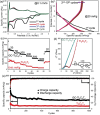Nitrogen-Doped Graphene-Like Carbon Intercalated MXene Heterostructure Electrodes for Enhanced Sodium- and Lithium-Ion Storage
- PMID: 38829277
- PMCID: PMC11336969
- DOI: 10.1002/advs.202402708
Nitrogen-Doped Graphene-Like Carbon Intercalated MXene Heterostructure Electrodes for Enhanced Sodium- and Lithium-Ion Storage
Abstract
MXene is investigated as an electrode material for different energy storage systems due to layered structures and metal-like electrical conductivity. Experimental results show MXenes possess excellent cycling performance as anode materials, especially at large current densities. However, the reversible capacity is relatively low, which is a significant barrier to meeting the demands of industrial applications. This work synthesizes N-doped graphene-like carbon (NGC) intercalated Ti3C2Tx (NGC-Ti3C2Tx) van der Waals heterostructure by an in situ method. The as-prepared NGC-Ti3C2Tx van der Waals heterostructure is employed as sodium-ion and lithium-ion battery electrodes. For sodium-ion batteries, a reversible specific capacity of 305 mAh g-1 is achieved at a specific current of 20 mA g-1, 2.3 times higher than that of Ti3C2Tx. For lithium-ion batteries, a reversible capacity of 400 mAh g-1 at a specific current of 20 mA g-1 is 1.5 times higher than that of Ti3C2Tx. Both sodium-ion and lithium-ion batteries made from NGC-Ti3C2Tx shows high cycling stability. The theoretical calculations also verify the remarkable improvement in battery capacity within the NGC-Ti3C2O2 system, attributed to the additional adsorption of working ions at the edge states of NGC. This work offers an innovative way to synthesize a new van der Waals heterostructure and provides a new route to improve the electrochemical performance significantly.
Keywords: MXene; batteries; energy storage; graphene; heterostructures.
© 2024 The Author(s). Advanced Science published by Wiley‐VCH GmbH.
Conflict of interest statement
The authors declare no conflict of interest.
Figures




Similar articles
-
A two-dimensional MXene/BN van der Waals heterostructure as an anode material for lithium-ion batteries.Phys Chem Chem Phys. 2022 Jun 8;24(22):13713-13719. doi: 10.1039/d1cp05707c. Phys Chem Chem Phys. 2022. PMID: 35612407
-
Improved lithium ion storage performance of Ti3C2Tx MXene@S composite with carboxymethyl cellulose binder.J Colloid Interface Sci. 2023 Jul;641:15-25. doi: 10.1016/j.jcis.2023.03.074. Epub 2023 Mar 13. J Colloid Interface Sci. 2023. PMID: 36924542
-
Strongly Coupled 2D Transition Metal Chalcogenide-MXene-Carbonaceous Nanoribbon Heterostructures with Ultrafast Ion Transport for Boosting Sodium/Potassium Ions Storage.Nanomicro Lett. 2021 Apr 22;13(1):113. doi: 10.1007/s40820-021-00623-5. Nanomicro Lett. 2021. PMID: 34138334 Free PMC article.
-
Recent Advances in Layered Ti3 C2 Tx MXene for Electrochemical Energy Storage.Small. 2018 Apr;14(17):e1703419. doi: 10.1002/smll.201703419. Epub 2018 Feb 5. Small. 2018. PMID: 29399994 Review.
-
High-Performance Sodium-Ion Batteries with Graphene: An Overview of Recent Developments and Design.ChemSusChem. 2025 Jan 14;18(2):e202400958. doi: 10.1002/cssc.202400958. Epub 2024 Oct 16. ChemSusChem. 2025. PMID: 39137130 Review.
Cited by
-
2D Carbonaceous Materials for Molecular Transport and Functional Interfaces: Simulations and Insights.Acc Chem Res. 2024 Sep 17;57(18):2678-2688. doi: 10.1021/acs.accounts.4c00398. Epub 2024 Aug 27. Acc Chem Res. 2024. PMID: 39190683 Free PMC article.
-
Metal-Organic Skeleton-Derived W-Doped Ga2O3-NC Catalysts for Aerobic Oxidative Dehydrogenation of N-Heterocycles.Materials (Basel). 2024 Sep 29;17(19):4804. doi: 10.3390/ma17194804. Materials (Basel). 2024. PMID: 39410375 Free PMC article.
-
Heterostructured CoO/MoB MBene composites for high performance lithium-ion batteries anode.iScience. 2025 Mar 6;28(4):112133. doi: 10.1016/j.isci.2025.112133. eCollection 2025 Apr 18. iScience. 2025. PMID: 40162369 Free PMC article.
References
-
- Naguib M., Kurtoglu M., Presser V., Lu J., Niu J., Heon M., Hultman L., Gogotsi Y., Barsoum M. W., Adv. Mater. 2011, 23, 4248. - PubMed
-
- Naguib M., Barsoum M. W., Gogotsi Y., Adv. Mater. 2021, 2103393. - PubMed
-
- Naguib M., Mochalin V. N., Barsoum M. W., Gogotsi Y., Adv. Mater. 2014, 26, 992. - PubMed
-
- Anasori B., Lukatskaya M. R., Gogotsi Y., Nat. Rev. Mater. 2017, 2, 16098.
LinkOut - more resources
Full Text Sources
